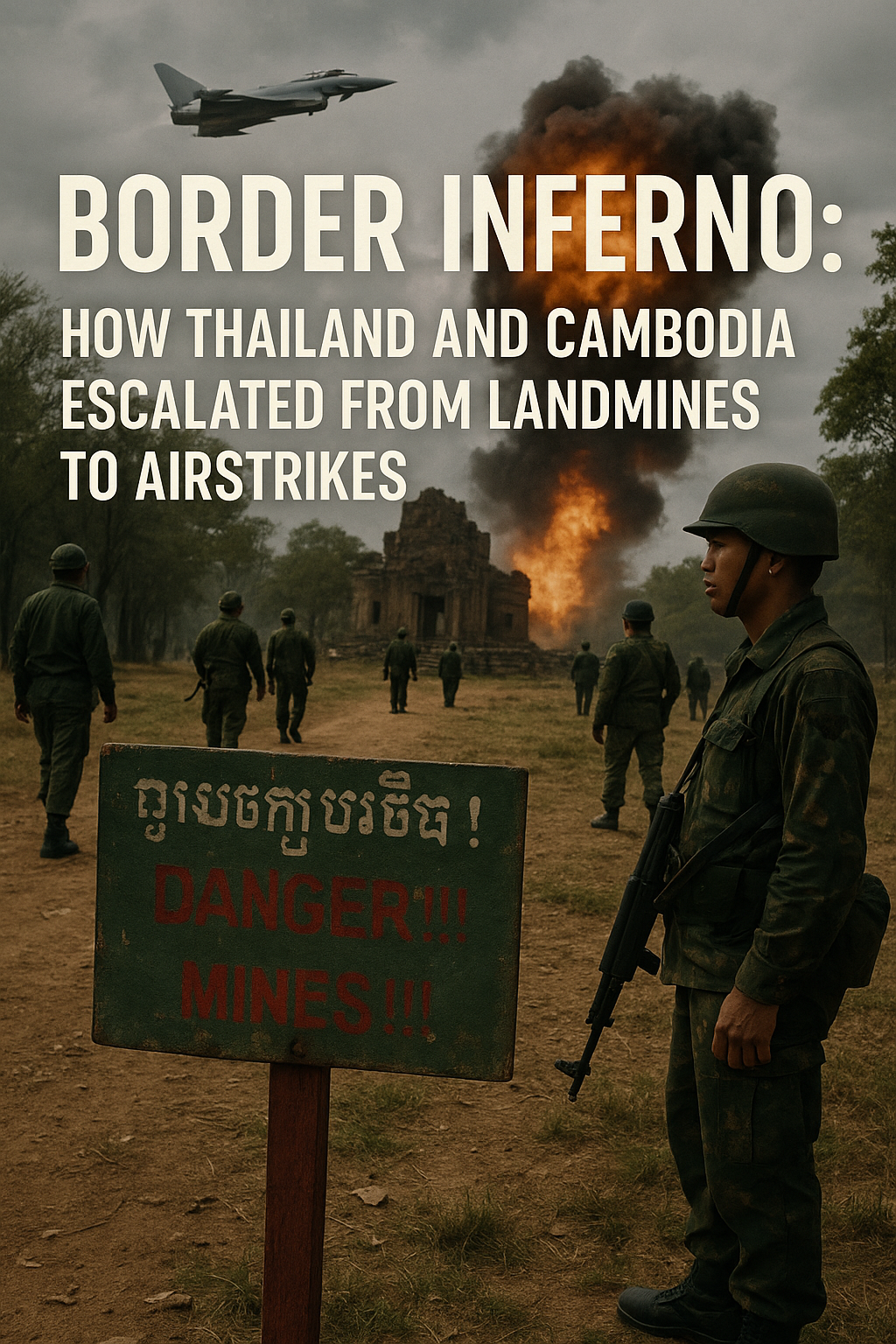Ancient Lines, Modern Flames: Inside the 2025 Thailand–Cambodia Clash
This blog unpacks the origins of the flare-up, the key military and humanitarian developments, the international response, and what might come next for both neighbors.-Rafael Benavente

Clash at the Frontier: What’s Driving the 2025 Thailand–Cambodia Border Conflict?
Introduction
In late July 2025, a long-standing, low-level dispute between Thailand and Cambodia erupted into one of the deadliest border confrontations in decades. What began as a landmine incident quickly spiraled into artillery exchanges, airstrikes, and mass evacuations—shocking a region accustomed to cautious peace. This blog unpacks the origins of the flare-up, the key military and humanitarian developments, the international response, and what might come next for both neighbors.
A Century-Old Dispute Reignited
The Thailand–Cambodia border dispute dates back to colonial-era maps, with both sides claiming sovereignty over forested hills, ancient temples, and strategic passes. In 1962, the International Court of Justice awarded the Preah Vihear temple to Cambodia, yet tensions regularly simmered as both armies patrolled the undefined frontier .
Incidents in early 2025 hinted that old grievances were far from settled: in February and May, explosive encounters injured Thai border guards and prompted diplomatic protests. Despite periodic joint military talks, neither government fully demarcated the boundary, leaving local outposts vulnerable to misunderstanding—and, eventually, open conflict .
From Landmine to Full-Blown Skirmish
On July 23, a Thai patrol in Ubon Ratchathani’s Nam Yuen district struck a newly laid landmine, costing one soldier his right leg and injuring four comrades. Thailand swiftly condemned what it called a “violation of human rights and international agreements,” blaming Cambodian forces for planting mines in “combat-ready” condition .
The following day, Thai artillery and F-16 fighter jets targeted several Cambodian positions near the Ta Muen Thom temple, a UNESCO World Heritage site claimed by both nations. Cambodia retaliated with heavy guns and small arms fire across at least 12 flashpoints along the 800-kilometer frontier. By July 25, both armies had declared open “Yuttha Bodin” offensives—each insisting it acted in self-defense .
Humanitarian Toll
The human cost escalated rapidly. By July 26, Reuters reported 32 fatalities—mostly civilians—and over 130 wounded on both sides . Artillery shells obliterated homes, schools, and medical clinics, while airstrikes leveling villages left thousands homeless.
An estimated 138,000 Thais and 4,000 Cambodians fled their border communities, seeking refuge in evacuation centers, schools, and makeshift camps . Witnesses described scenes of desperation: children clutching tattered blankets, elders too frail to walk being carried on bamboo stretchers, and families praying for a ceasefire that seemed ever elusive.
Local aid organizations have scrambled to deliver food, water, and medical care, but access remains perilous amid continuing shelling. Thailand’s military closed four border checkpoints and indefinitely shuttered two temples—further disrupting cross-border trade that many villagers depend on for their livelihoods.
Blame and Legal Accusations
Each government points its finger squarely at the other. Thailand’s acting Prime Minister Phumtham Wechayachai accused Cambodia of war crimes—citing alleged use of cluster munitions and airstrikes on civilian targets . Phnom Penh, in turn, decried the F-16 bombings as disproportionate and unlawful, demanding an investigation at the International Court of Justice if necessary.
Both sides have lodged formal complaints at the United Nations. Thailand recalled its ambassador from Phnom Penh and expelled Cambodia’s envoy in Bangkok—a diplomatic tit-for-tat that underscores how badly bilateral trust has eroded.
International and Regional Responses
The sudden collapse of calm alarmed global and ASEAN leaders alike.
- United Nations: The Security Council convened an emergency meeting, with UN Secretary-General urging both parties to exercise “maximum restraint” and avoid actions that could widen the conflict .
- ASEAN: As current chair, Malaysia offered to mediate. While officials from Bangkok and Phnom Penh indicate openness to bilateral talks, neither has yet agreed to third-party facilitation.
- Major Powers: China and the United States called for a ceasefire, emphasizing that regional stability hinges on peaceful border management. France and the EU echoed these calls, given their historical ties to Cambodia.
Despite mounting pressure, Thailand has rejected international mediation—insisting the dispute is a matter of bilateral sovereignty. Cambodia likewise maintains that once Thailand halts its air and artillery strikes, negotiations can resume.
What Comes Next?
Analysts warn of several possible trajectories:
- Prolonged Stalemate
Both militaries dig in, resulting in a protracted low-intensity conflict that periodically flares. Humanitarian suffering would continue, but full-scale war remains unlikely if neither side seeks deeper escalation. - Diplomatic Breakthrough
Under ASEAN or UN auspices, Thailand and Cambodia return to the negotiating table—potentially agreeing to joint patrols, third-party monitoring, or expedited boundary demarcation. A formal ceasefire and phased troop withdrawals could follow. - Regional Spillover
Nationalist fervor and political instability (Thailand’s caretaker government, Cambodia’s upcoming elections) could incentivize leaders to stoke conflict for domestic gain. This risk raises the specter of neighboring Laos or Vietnam being drawn in via alliance obligations.
For thousands of displaced civilians, however, these scenarios offer little immediate comfort. Humanitarian corridors, de-mining operations, and long-term reconstruction efforts will be essential in healing the borderlands—regardless of how the two capitals choose to settle their dispute.
Conclusion
The July 2025 clashes between Thailand and Cambodia serve as a stark reminder that colonial-era boundaries—unresolved and poorly defined—retain the power to ignite violence. While both governments profess a desire for peace, entrenched mistrust and competing claims over strategic hills and temples have transformed ancient grievances into a modern crisis.
Whether cooler heads can prevail through ASEAN diplomacy or UN intervention remains to be seen. But one thing is clear: the human toll has already been heavy, and without urgent de-escalation, this local border clash risks becoming a broader threat to Southeast Asian stability.
By Rafael Benavente
References
- Reuters, “Thailand and Cambodia exchange heavy artillery fire as border battle expands” Reuters
- The Guardian, “Thailand-Cambodia border clashes” The Guardian
- AFP via Aftonbladet, “En väpnad konflikt …” Aftonbladet
- AP News, “Tens of thousands flee their homes as Thailand and Cambodia clash” AP News
- Wikipedia, “2025 Cambodia–Thailand border conflict” en.wikipedia.org
